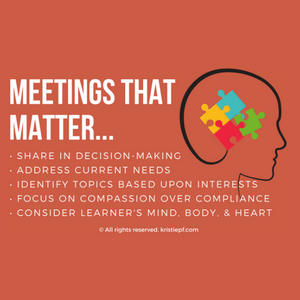 A colleague of mine refers to this time of year as “March Madness”…and it doesn’t have anything to do with basketball.
A colleague of mine refers to this time of year as “March Madness”…and it doesn’t have anything to do with basketball.
Instead, she is referring to the general feeling she has across elementary school buildings…a feeling that chaos reigns supreme, everyone has gone mad, and adults and children are misbehaving at alarming rates.
During “March Madness” she notices greater staff resistance, greater defensiveness when she offers solutions, and she is certain, they are rolling their eyes, even more than usual.
As she talks to staff, she hears more and more about children’s “misbehaviors” that range from flat out aggression to apathy. Her staff report feeling that things are out of control, and are turning to her to “fix things”…and quick!
One thing she knows that is out of control is the number of behavioral referrals and the ineffective decision that some building leaders are making to remove children from the educational setting.
On a good day, she knows that what she and the staff are experiencing is not “misbehavior”, but rather “stress behavior”.
But how in the world does she turn things around? How does she help everyone see the stressors and aim to reduce and remove them…vs. the children?
Sure…she can hold her breath until spring break…but that’s only a week long and there are months of school left after that. She empathizes with her staff, but she also knows the answer is NOT to expel and suspend four-year olds.
How can she get staff…who seem resistant to everything (even things they typically enjoy), to approach these challenges differently? How can she offer #professionallearning opportunities that will positively impact the children they serve?
As we sat together and brainstormed, we first thought of ways we could address staff resistance. Next, we identified signifiant learning outcomes so she was clear about her goals. It’s easy to just want something uncomfortable to go away and start tossing out possible solutions. We had to take a breath, think about “mindset before methods”, and consider what it was that she wanted to accomplish.
Here are her top three desired outcomes:
- Staff will make connections between stressors in the social and physical learning environment, and children’s challenging responses
- Staff will revise their own approach to addressing behaviors that challenge them by raising their #emotionalintelligence
- Staff will become more aware and better able to respond when children are in flight, fight, freeze, or faint mode.
Once we had a plan in place to address resistance, we needed to find a way to achieve her desired outcomes for learning new ways to address children’s behaviors…particularly those that are challenging.
We landed on the idea of having staff register for Dr. Barb O’Neill’s 2nd Annual Transform Challenging Behavior Conference. A 100% free and 100% online conference dedicated to transforming challenging behaviors in young children.
And since she was going to provide professional development at a difficult time…we had to think through ways to make it effective. We knew we couldn’t just require everyone to register for the conference…and poof…everything would be better.
Effective professional learning happens when districts and schools created systems where all educators have regularly scheduled time during the school day to learn, collaborate, and plan for powerful instruction.” @Stephanie Hirsh
We took time to think through how her staff would interact with the conference content and participants, and identified ways to make the conference meaningful to their work with children and families.
We also employed four strategies for engaging with conference content. The strategies would allow staff to make connections between stressors and learning, to raise their #EQ, and to learn how to better respond when children are hyper and/or hypo aroused. Click here to read more about the four strategies and request a free infographic that explains each.
- Model Demo: Staff would be expected to take three tips and/or strategies from across conference sessions, put it into practice in their classroom, videotape the practices in action, and post the videos to a shared drive for others to review and comment.
- Buffet Line: Staff would be expected to pick three of the 21 conference sessions they were most interested in “attending” and incorporate what they learned into lesson plans and in their communications with families across the remainder of the year.
- Problem-Solve: An hour would be set aside during a staff meeting, which would serve as a “watch party”. The staff would vote on which session to watch together, and then would brainstorm barriers and possible solutions based upon what was presented.
- Learning Centers: Three sessions that mostly closely aligned with the original outcomes (understanding stressors, raising #EQ, and responding to behaviors) would be identified. Additional books, articles, podcasts, and other resources by those speakers would be collected and placed into three folders in a shared space. Staff could then review the content as interested/needed, and put what they learn into practice.
Speaking of learning…to learn more about the 2nd Annual Transform Challenging Behavior Conference, watch this FB live broadcast where I talk with Barb O’Neill about her vision for the conference, how it works, our top tips for addressing behaviors that are challenging, and a few more surprises.
To access the ALL sessions from the 2nd annual Transform Challenging Behaviors Online Conference, here.
Get Access Now!

